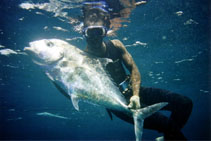| Family: |
Carangidae (Jacks and pompanos), subfamily: Caranginae |
| Max. size: |
100 cm TL (male/unsexed); max.weight: 3,170.0 g |
| Environment: |
pelagic-neritic; marine; depth range - 70 m |
| Distribution: |
Eastern Atlantic: off Morocco to Angola (Ref. 4225, 57392), including southern parts of the Mediterranean (Ref. 4225). |
| Diagnosis: |
Dorsal spines (total): 8; Dorsal soft rays (total): 20-22; Anal spines: 3; Anal soft rays: 18-20. Diagnosis: body deep and strongly compressed, becoming elongate with growth (body depth comprised from 1.3 to 1.8 times in fork length); dorsal profile abrupt; mouth large, upper jaw ending below posterior half of eye; dorsal fin with 7 spines, becoming resorbed and indistinct at about 150 mm fork length, followed by 1 spine and 20-22 soft rays; anal fin with 2 spines, becoming resorbed and indistinct at very small sizes, followed by 1 spine and 18-20 soft rays; 1st dorsal- and anal-fin rays extremely long and filamentous in young individuals, becoming shorter in adults; pectoral fins falcate, longer than head; pelvic fins elongate in young individuals; scales very small and cycloid, hardly visible, absent on some parts of head and body; straight part of lateral line with 4-20 scutes; base of caudal fin with bilateral paired keels (Ref. 57392).
Coloration: silvery, with a faint metallic-blue tint on upper third of body and head; juveniles with 5 dark crossbars on sides (Ref. 57392). |
| Biology: |
Adults solitary in coastal water near the bottom to at least 50 m and strong swimmers (Ref. 7079, 57392). Juveniles usually pelagic and drifting, sometimes occurring in brackish water (Ref. 4225, 57392). Feed on squid and other fishes (Ref. 4233). Eggs are pelagic (Ref. 4233). |
| IUCN Red List Status: |
Least Concern (LC); Date assessed: 09 May 2013 Ref. (130435)
|
| Threat to humans: |
harmless |
Source and more info: www.fishbase.org. For personal, classroom, and other internal use only. Not for publication.

